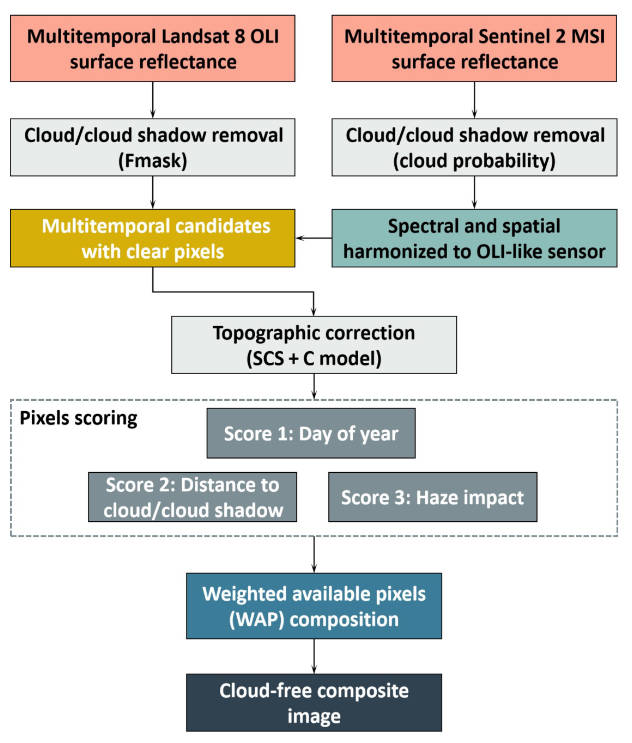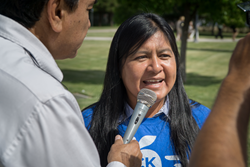Revolutionizing Clear View Image Compositing: The Multifactor Weighting Method for Enhanced Composite Images
KNOXVILLE, TN, January 19, 2024 /24-7PressRelease/ — The burgeoning availability of open-source remote sensing data from Landsat and Sentinel satellites has markedly propelled global monitoring studies forward. Despite these advances, persistent challenges such as cloud contamination and atmospheric disturbances like haze continue to compromise the quality and consistency of satellite imagery. Traditional pixel-based compositing methods, although designed to produce clearer images, have encountered difficulties in maintaining uniformity, particularly due to fluctuating vegetation states. These issues underscore the complexity of achieving reliable and accurate Earth observation data.
For a study published in the Journal of Remote Sensing on 28 September 2023, a team of researchers from the Chinese Academy of Forestry and the University of Maryland has developed a sophisticated Multifactor Weighting (MFW) method for creating clear, seamless, and radiometrically consistent image composites using all available Landsat 8 and Sentinel 2 images in Google Earth Engine.
The MFW method developed by the team integrates multiple factors, including acquisition day of the year (DOY), proximity to cloud or cloud shadow, and haze impact, to calculate a composite score for each pixel. This score is then used to weight observations, ensuring a more seamless integration of imagery from different dates and conditions. The method was rigorously tested across four distinct climate zones in China and demonstrated superior consistency and visual quality compared to traditional Best Available Pixel (BAP) methods. It effectively mitigates issues like artificial patchiness and enhances the overall quality of the composite images.
Lead researcher, Dr. Shili Meng, remarked, “The MFW method represents a quantum leap in satellite image processing. It not only addresses common discontinuities found in composite images but also significantly enhances the spatial and radiometric consistency of the imagery, paving the way for more accurate global monitoring.
The team aims to further refine the MFW method and expand its application to other regions and types of satellite data. They acknowledge challenges such as improving cloud masking algorithms and adapting the method to handle the ever-increasing volume and variety of remote sensing data. Continuous enhancements and community collaboration will be critical in overcoming these challenges and realizing the full potential of the MFW method.
This new method has significant implications for various fields relying on remote sensing data, including environmental monitoring, climate change studies, disaster response, and agricultural planning. By providing clearer, more consistent composite images, the MFW method can greatly enhance the accuracy of observations and the decision-making processes based on this data.
References
DOI
10.34133/remotesensing.0086
Original Source URL
https://doi.org/10.34133/remotesensing.0086
Funding information
The National Key Research and Development Program of China (2019YFE0126700);
The Asia-Pacific Network for Sustainable Forest Management and Rehabilitation (2018P1-CAF).
Contact
Yong Pang, Institute of Forest Resource Information Techniques, Chinese Academy of Forestry, Beijing 100091, China, pangy@ifrit.ac.cn
About Journal of Remote Sensing
The Journal of Remote Sensing, an online-only Open Access journal published in association with AIR-CAS, promotes the theory, science, and technology of remote sensing, as well as interdisciplinary research within earth and information science.
Chuanlink Innovations, where revolutionary ideas meet their true potential. Our name, rooted in the essence of transmission and connection, reflects our commitment to fostering innovation and facilitating the journey of ideas from inception to realization.
Related Link:
http://chuanlink-innovations.com
—
For the original version of this press release, please visit 24-7PressRelease.com here





![[Interview] Nam-Hoon Kang, Chairman of H2 MEET: “Korea, Leading Hydrogen Technology Through Strong Public-Private Cooperation, Will Bring Synergy to the Global Hydrogen Economy with H2 MEET”](https://www.24-7pressrelease.com/attachments/051/press_release_distribution_0515414_209861.jpeg)




